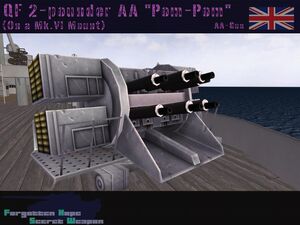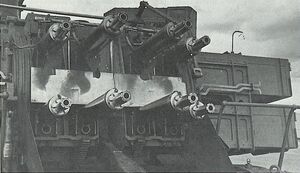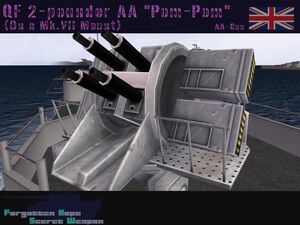Mark VI Mount[]
| QF 2-pounder Mk.VIII on a Mk.VI Mount (8 Barrels) | |
|---|---|

| |
| General Historical Information | |
| Place of origin: | Great-Britain |
| Category: | Anti-Aircraft Gun |
| Used by: |
Great-Britain |
| Debut in FHSW: | Debut in FH Mod |
| Passengers: | 1 |
| Calibre: | 40 mm |
| Ammunition: | HE and HET |
| Elevation: | −5° / +90° |
| Traverse: | 360° |
| Rate of Fire: | 1 Gun: 115 rpm (ingame 28 rpm) 8 Guns together: 920 rpm (ingame 227 rpm) |
| Maximum Range: | 6,220 m |
| Used by vehicles / ships: | HMS Ark Royal HMS Prince of Wales (53) HMS Lion HMS Hood (51) |
| Position 1: | Gunner |
| Historical Picture | |

| |
The Vickers QF 2-Pounder AA, had the nickname Pom-Pom because of his sound, can not be confused with the Ordnance QF 2-pounder AT Gun! It was a British designed anti-aircraftgun for the navy, wich saw service since 1915!
It began with the 37 mm Nordenfelt-Maxim or also know as the QF 1-Pounder "Pom-Pom" or "Maxim Pom-Pom". It was designed by Hiram Maxim in the late 1880's and it was a larger version of the Maxim machinegun. The QF 1 Pounder will be know as the most used AA-Gun during the First World War. The complete British commonwealth will use the gun during the war. Also the Germans will use the gun as the Flak Maxim M1914. It saw service on sea and on land, in the Westernfront aswel in Asia and in Africa. Of course, many other country's also use the QF-1 Pounder, including Belgium and the USA.
The QF 2-pounder Mark II was the first version of the 2 Pounders and it was essentially a scaled-up version of the QF 1 pounder Maxim gun produced by Vickers. It was a 40 mm calibre gun with a water-cooled barrel and a Vickers-Maxim mechanism. It was ordered in 1915 by the Royal Navy as an anti-aircraft weapon for ships (Despite the order by the navy for their ships, some examples saw also service on land fixed on lorry's). The original models fired from hand-loaded fabric belts, although these were later replaced by steel-link belts. This "scaling-up" process was not entirely successful, as it left the mechanism rather light and prone to faults such as rounds falling out of the belts. In 1918, one example of this weapon was experimentally mounted on the upper envelope of His Majesty's Airship 23r.
Surviving weapons were brought out of storage to see service in World War II, mainly on board ships such as naval trawlers, Motor Boats and "armed yachts". It was used almost exclusively in the single-barrel, unpowered pedestal mountings P Mark II (Royal Navy nomenclature gave mountings and guns their own distinct Mark numbers) except for a small number of weapons on the mounting Mark XV, which was a twin-barreled, powered mount. These were too heavy to be of any use at sea, and were therefore mounted ashore. All were scrapped by 1944.
The Royal Navy had identified the need for a rapid-firing, multi-barrelled close-range anti-aircraft weapon at an early stage. Design work for such a weapon began in 1923 based on the earlier Mark II, undoubtedly to utilise the enormous stocks of 2-pounder ammunition left over from the First World War. Lack of funding led to a convoluted and drawn-out design and trials history, and it was not until 1930 that these weapons began to enter service. Known as the QF 2-pounder Mark VIII, it is usually referred to as the multiple pom-pom. The initial mounting was the 11.8 to 17.35 ton, eight-barrelled mounting Mark V (later Mark VI), suitable for ships of cruiser and aircraft carrier size upward. These multiple gun mounts required four different guns and were nicknamed the "Chicago Piano". The mount had two rows each of four guns. Guns were produced in both right- and left-hand and "inner" and "outer" so that the feed and ejector mechanisms matched. An interesting feature was the very large magazine, from 140 rounds per gun for the eight-barrelled mount. This large ammunition capacity gave the eight-barrelled mount the ability to fire continuously for 73 seconds without reloading. In FHSW, it can fire 280 rounds in 74 seconds! But the gun is not reloaded in 45 seconds!
The QF 2-pounder AA fire 40mm HE (High Explosive) and HET (High Explosive Tracer) rounds. The last one is very beneficial and detrimental during night battles. The Tracer & Igniter N°7 Mk. IV, wich is equiped in the bottom of the HET rounds, gives enormous light that you can easy see where you shooting. However, despit this advantage, the gun betrays the location of the ship for enemy aircrafts and ships. The rounds are very powerfull but also very inaccurate. Howevern the 8 barreled mount gives you a high probability that you hit a target. The mount can also be found on ground as stationary AA-Gun.
Mark VII Mount[]
| QF 2-pounder Mk.VIII on a Mk.VII Mount (4 Barrels) | |
|---|---|

| |
| General Historical Information | |
| Place of origin: | Great-Britain |
| Category: | Anti-Aircraft Gun |
| Used by: |
Great-Britain |
| Debut in FHSW: | Debut in FH Mod |
| Passengers: | 1 |
| Calibre: | 40 mm |
| Ammunition: | HE and HET |
| Elevation: | −5° / +90° |
| Traverse: | 360° |
| Rate of Fire: | 1 Gun: 115 rpm
8 Guns together: 230 rpm |
| Maximum Range: | 6,220 m |
| Used by vehicles / ships: | HMS Laforey (G99) HMS Lance (G87) |
| Position 1: | Gunner |
| Historical Picture | |

| |
From 1935, the quadruple mounting Mark VII, essentially half a Mark V or VI, entered service for ships of destroyer and cruiser size. These multiple gun mounts required four different guns and were nicknamed the "Chicago Piano". The mount had two rows each of two guns. Guns were produced in both right- and left-hand and "inner" and "outer" so that the feed and ejector mechanisms matched. An interesting feature was the very large magazine, 70 rounds per gun. The QF 2-pounder AA fire 40mm HE (High Explosive) and HET (High Explosive Tracer) rounds. The last one is very beneficial and detrimental during night battles. The Tracer & Igniter N°7 Mk. IV, wich is equiped in the bottom of the HET rounds, gives enormous light that you can easy see where you shooting. However, despit this advantage, the gun betrays the location of the ship for enemy aircrafts and ships. The rounds are very powerfull but also very inaccurate. The 4 barreled mount gives you a high probability that you hit a target, but you need still have the skill to do this! The mount can also be found on ground as stationary AA-Gun.
Mark XVI Mount[]
| QF 2-pounder Mk.VIII on a Mark XVI Mount (1 Barrel) | |
|---|---|

| |
| General Historical Information | |
| Place of origin: | Great-Britain |
| Category: | Anti-Aircraft Gun |
| Used by: |
Great-Britain |
| Debut in FHSW: | Debut in FH Mod |
| Passengers: | 1 |
| Calibre: | 40 mm |
| Ammunition: | HE and HET |
| Elevation: | −5° / +90° |
| Traverse: | 360° |
| Rate of Fire: | 1 Gun: 115 rpm
8 Guns together: 230 rpm |
| Maximum Range: | 6,220 m |
| Used by vehicles / ships: | HMS Audacity HMS Bluebell HMS Snapdragon HMS Celandine |
| Position 1: | Gunner |
| Historical Picture | |

| |
Single-barrelled mounts, the Mark VIII (manual) and Mark XVI (power operated), were also widely used, mainly in small escorts (such as the Flower-class corvettes) and coastal craft (especially early Fairmile 'D' motor gunboats). The Mark XVI mounting was related to the twin mounting Mark V for the Oerlikon 20 mm cannon and the "Boffin" mounting for the 40 mm Bofors M1936 gun. An interesting feature was the very large magazine, 56 rounds. The QF 2-pounder AA fire 40mm HE (High Explosive) and HET (High Explosive Tracer) rounds. The last one is very beneficial and detrimental during night battles. The Tracer & Igniter N°7 Mk. IV, wich is equiped in the bottom of the HET rounds, gives enormous light that you can easy see where you shooting. However, despit this advantage, the gun betrays the location of the ship for enemy aircrafts and ships. The rounds are very powerfull but also very inaccurate. The 1 barreled mount gives you a very low probability that you hit a target. The mount can also be found on ground as stationary AA-Gun.
| |||||||||||
| ||||||||||||||||||||||||||||||||












